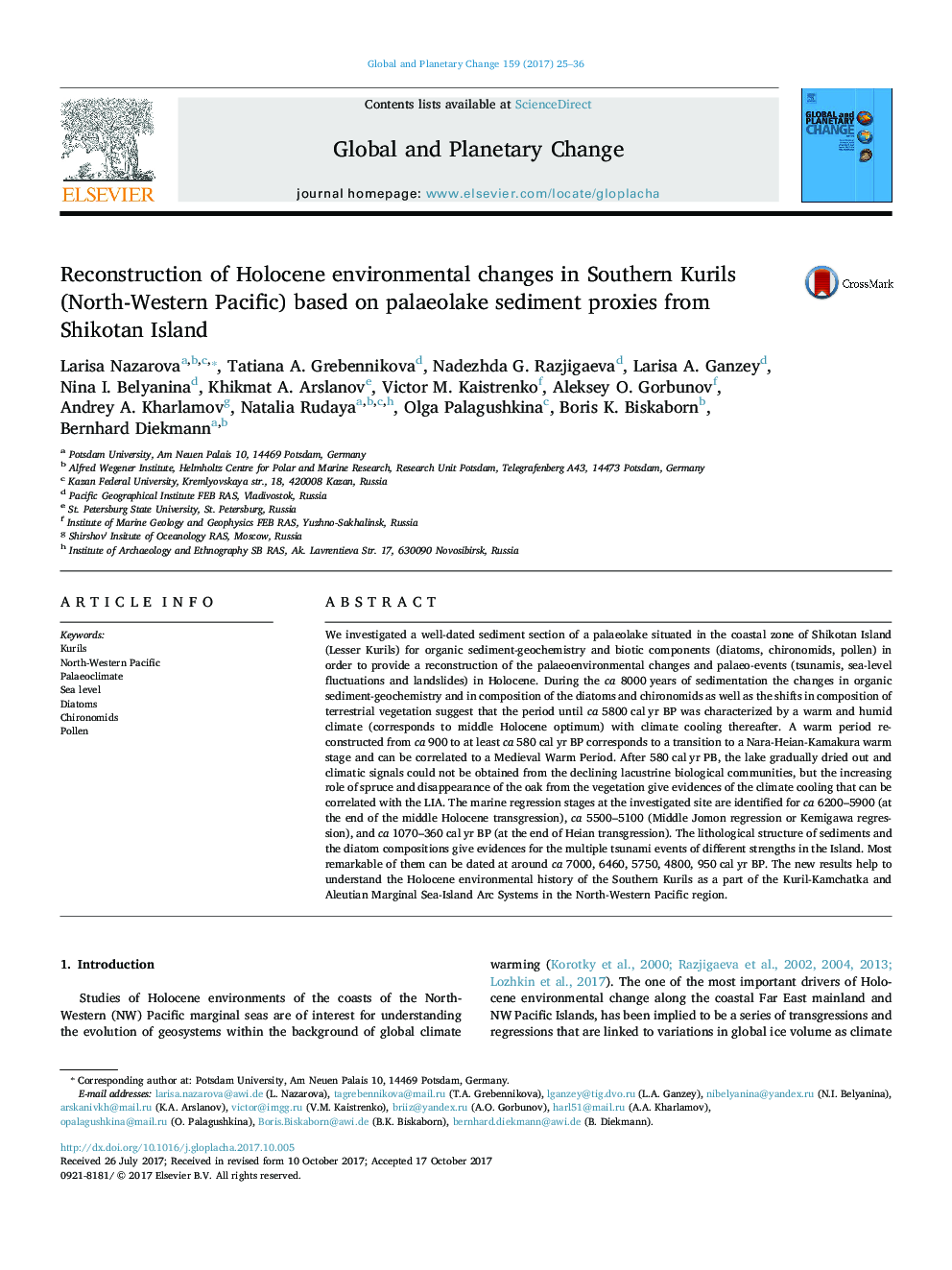| کد مقاله | کد نشریه | سال انتشار | مقاله انگلیسی | نسخه تمام متن |
|---|---|---|---|---|
| 8867665 | 1621623 | 2017 | 12 صفحه PDF | دانلود رایگان |
عنوان انگلیسی مقاله ISI
Reconstruction of Holocene environmental changes in Southern Kurils (North-Western Pacific) based on palaeolake sediment proxies from Shikotan Island
ترجمه فارسی عنوان
بازسازی تغییرات زیست محیطی هولوسن در کوریل جنوبی (شمال غربی اقیانوس آرام) بر اساس پروکسی های رسوبی پالئولیک از جزیره شیکوتان
دانلود مقاله + سفارش ترجمه
دانلود مقاله ISI انگلیسی
رایگان برای ایرانیان
کلمات کلیدی
موضوعات مرتبط
مهندسی و علوم پایه
علوم زمین و سیارات
فرآیندهای سطح زمین
چکیده انگلیسی
We investigated a well-dated sediment section of a palaeolake situated in the coastal zone of Shikotan Island (Lesser Kurils) for organic sediment-geochemistry and biotic components (diatoms, chironomids, pollen) in order to provide a reconstruction of the palaeoenvironmental changes and palaeo-events (tsunamis, sea-level fluctuations and landslides) in Holocene. During the ca 8000 years of sedimentation the changes in organic sediment-geochemistry and in composition of the diatoms and chironomids as well as the shifts in composition of terrestrial vegetation suggest that the period until ca 5800 cal yr BP was characterized by a warm and humid climate (corresponds to middle Holocene optimum) with climate cooling thereafter. A warm period reconstructed from ca 900 to at least ca 580 cal yr BP corresponds to a transition to a Nara-Heian-Kamakura warm stage and can be correlated to a Medieval Warm Period. After 580 cal yr PB, the lake gradually dried out and climatic signals could not be obtained from the declining lacustrine biological communities, but the increasing role of spruce and disappearance of the oak from the vegetation give evidences of the climate cooling that can be correlated with the LIA. The marine regression stages at the investigated site are identified for ca 6200-5900 (at the end of the middle Holocene transgression), ca 5500-5100 (Middle Jomon regression or Kemigawa regression), and ca 1070-360 cal yr BP (at the end of Heian transgression). The lithological structure of sediments and the diatom compositions give evidences for the multiple tsunami events of different strengths in the Island. Most remarkable of them can be dated at around ca 7000, 6460, 5750, 4800, 950 cal yr BP. The new results help to understand the Holocene environmental history of the Southern Kurils as a part of the Kuril-Kamchatka and Aleutian Marginal Sea-Island Arc Systems in the North-Western Pacific region.
ناشر
Database: Elsevier - ScienceDirect (ساینس دایرکت)
Journal: Global and Planetary Change - Volume 159, December 2017, Pages 25-36
Journal: Global and Planetary Change - Volume 159, December 2017, Pages 25-36
نویسندگان
Larisa Nazarova, Тatiana Ð. Grebennikova, Nadezhda G. Razjigaeva, Larisa Ð. Ganzey, Nina I. Belyanina, Khikmat Ð. Arslanov, Victor Ð. Kaistrenko, Ðleksey Ð. Gorbunov, Ðndrey Ð. Kharlamov, Natalia Rudaya, Olga Palagushkina, Boris K. Biskaborn,
